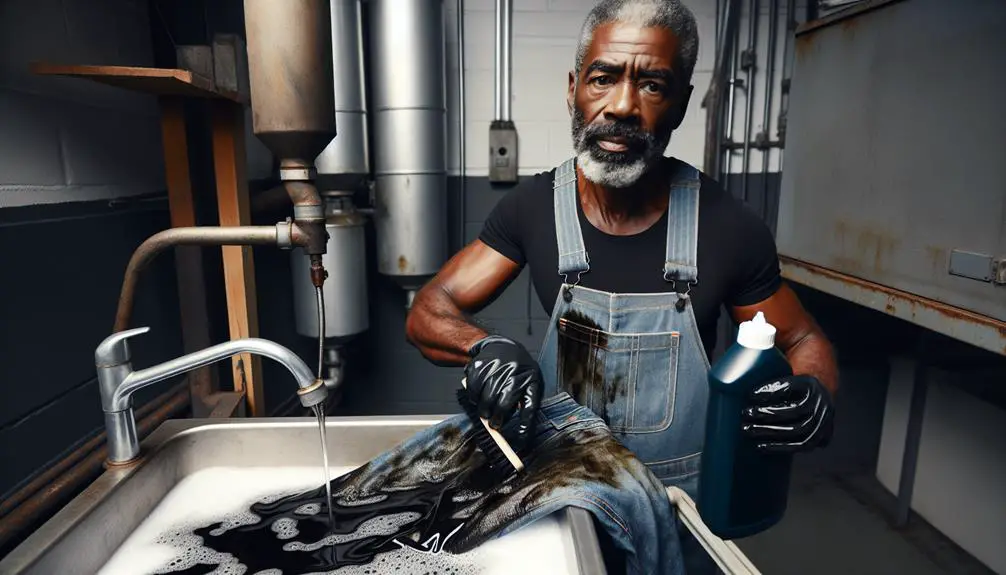Getting gear oil out of clothes can be quite the challenge, but fret not, there are ways to tackle this oily ordeal. From pre-treating with dish soap to using a grease-fighting spray, there are various methods to help salvage your soiled garments.
However, one must proceed with caution and patience to guarantee the best results. So, let's roll up our sleeves and plunge into the world of stain removal, where a few simple steps can make all the difference in salvaging your favorite attire.
Table of Contents
Key Takeaways
- Pre-treat gear oil stains with white vinegar, baking soda paste, or dish soap.
- Soak clothes in a white vinegar solution before washing for effective stain removal.
- Use warm water for soaking and choose a heavy-duty detergent for washing.
- Apply liquid detergent directly to stains and follow optimal washing procedures for best results.
Pre-Treat With Dish Soap
I find that pre-treating gear oil stains with dish soap is a simple and effective way to remove them from clothes. When dealing with tough oil stains on fabrics, it's important to act fast and use the right products to guarantee successful oil stain removal without damaging the fabric. Dish soap is an excellent option for pre-treating gear oil stains due to its degreasing properties.
To pre-treat an oil stain with dish soap, dampen the stained area with water and then apply a small amount of dish soap directly onto the stain. Gently massage the soap into the fabric, working it into the fibers to help break down the oil. Let the dish soap sit on the stain for about 10-15 minutes to allow it to penetrate and lift the oil from the fabric effectively. After letting it sit, wash the garment as usual following the care instructions on the clothing label.
Apply Baking Soda Paste
For a powerful solution in tackling stubborn gear oil stains on clothes, consider applying a baking soda paste. I've found this method to be highly effective in breaking down the oil and lifting it from the fabric. Here are some tips to make the most of this technique:
- Confirmation Consistency: Make sure the baking soda and water are thoroughly combined to form a smooth paste that can adhere well to the stain.
- Application Technique: Gently rub the baking soda paste onto the affected area using a soft brush or cloth. This helps to work the mixture into the fabric fibers for better penetration.
- Time for Action: Allow the baking soda paste to sit on the stain for at least 30 minutes. This time lets the paste absorb the oil and begin the stain removal process.
- Rinse and Repeat: After the waiting period, rinse the garment with cold water. If the stain persists, you can reapply the baking soda paste and repeat the process.
Use White Vinegar Solution
I've found that using a white vinegar solution can be quite effective in removing gear oil stains from clothes.
The soaking method with vinegar seems to work wonders in breaking down the oil residue.
Once soaked, a regular wash with detergent usually completes the process, leaving the clothes clean and oil-free.
Vinegar for Oil Removal
To effectively remove gear oil from clothes, consider utilizing a white vinegar solution. Vinegar benefits are particularly useful for oil stain removal due to its acidic properties that help break down the oil molecules. Here are some key points to keep in mind when using white vinegar for this purpose:
- Pre-treat: Dab the stained area with undiluted white vinegar before washing.
- Mix with detergent: Add white vinegar to the washing machine along with your regular detergent.
- Soak: Let the garment soak in a solution of water and white vinegar before washing.
- Repeat if necessary: For stubborn stains, repeat the process until the oil is completely removed.
Using white vinegar can be a cost-effective and efficient way to tackle gear oil stains on clothes.
Soaking Method Effectiveness
In my experience, soaking clothes in a white vinegar solution has proven to be highly effective in removing gear oil stains. The key factors that impact the success of this method are the soaking duration and the type of garment being treated. Here is a table to summarize the most favorable conditions for using the white vinegar solution:
| Garment Type | Soaking Duration |
|---|---|
| Heavy Fabrics | 1-2 hours |
| Delicate Fabrics | 30 minutes |
When soaking clothes, using warm water can help loosen the oil from the fabric. Additionally, choosing a mild detergent for pre-treating the stain before soaking can enhance the cleaning process. By following these guidelines, you can effectively tackle gear oil stains using the white vinegar solution.
Wash With Detergent
When dealing with gear oil stains on clothes, the next step involves washing with detergent, utilizing the effective white vinegar solution for best results.
- Pre-treat: Apply white vinegar directly to the stain before washing to help break down the oil.
- Use the Right Detergent: Opt for a heavy-duty detergent designed to tackle tough stains like gear oil.
- Inspect Fabric Care Label: Guarantee the detergent and white vinegar are safe for the fabric before proceeding.
- Wash on the Hottest Setting: Hot water can help lift the oil from the fabric effectively.
Try Liquid Laundry Detergent
I find that using liquid laundry detergent can be a game-changer when dealing with gear oil stains.
The key points to remember are to apply the liquid detergent directly to the stained areas, let it sit for a bit to penetrate the fabric, and then wash the clothes in hot water for best results.
This method has been quite effective for me in removing tough gear oil stains from my clothes.
Use Liquid Detergent
Consider using a gentle liquid laundry detergent to effectively remove gear oil stains from clothes. When dealing with tough stains like gear oil, the right detergent can make all the difference.
Here are some tips for using liquid detergent to tackle those stubborn spots:
- Pre-soak: Allow the stained garment to soak in a mixture of water and liquid detergent before washing.
- Spot treatment: Apply a small amount of liquid detergent directly to the gear oil stain and gently rub it in before laundering.
- Follow instructions: Always follow the manufacturer's guidelines when using liquid detergent for stain removal.
- Use warm water: Warm water can help the detergent penetrate the fabric and lift the oil stains more effectively.
Pre-Treat Stained Areas
To effectively tackle stubborn gear oil stains on clothes, start by pre-treating the stained areas using a gentle liquid laundry detergent. This step is important in loosening the tough oil residue from the fabric fibers before washing.
When dealing with different fabric types, it's necessary to take into account suitable pre-treatment options to prevent damage. For example, delicate fabrics may require a milder detergent or a shorter pre-soak time to avoid weakening the fibers.
Understanding stain removal techniques and the specific needs of various fabrics can greatly improve the outcome of your laundry care routine. By applying the right pre-treatment and knowing how to handle different materials, you set yourself up for success in removing gear oil stains effectively.
Wash With Hot Water
When washing clothes to remove gear oil stains, consider using hot water along with a liquid laundry detergent for best results. Hot water helps to break down the oil and grease, making it easier to lift off the fabric fibers.
Here are some tips to enhance the effectiveness of washing with hot water:
- Boiling water method: For tougher gear oil stains, pre-soak the garment in boiling water before washing to help loosen the oil from the fabric.
- Steam cleaning technique: If your washing machine has a steam cleaning option, use it in combination with hot water for a deeper clean.
- Use a high-quality liquid laundry detergent formulated to tackle tough stains like gear oil.
- Follow the garment's care label instructions to make certain you use the appropriate water temperature for the fabric.
Use a Grease-Fighting Spray
Using a powerful grease-fighting spray can effectively tackle gear oil stains on clothes. When dealing with stubborn grease stains, having the right tools is crucial. Grease-fighting sprays are specifically designed to break down and lift grease from fabric fibers, making them a valuable addition to your laundry arsenal. Here are some key points to keep in mind when using a grease-fighting spray:
| Grease-Fighting Spray Tips | ||
|---|---|---|
| 1. Choose a quality spray | ||
| 2. Apply directly to the stain | ||
| 3. Let it sit before washing |
Apply Cornstarch or Talcum Powder
Ever wondered how cornstarch or talcum powder can help with removing stubborn gear oil stains from clothes? Applying these powders is a simple yet effective method for tackling tough oil stains. Here's how to make the most of this fabric care technique:
- Absorption Power: Cornstarch and talcum powder work by absorbing the oil from the fabric, making it easier to lift the stain.
- Gentle on Fabrics: These powders are gentle on most fabrics, reducing the risk of damage compared to harsh chemicals.
- Easy Application: Simply sprinkle a generous amount of cornstarch or talcum powder over the oil stain, ensuring it covers the affected area.
- Patience is Key: Allow the powder to sit on the stain for at least 30 minutes, giving it time to absorb the oil before brushing or shaking it off.
Use a Commercial Stain Remover
To tackle deeper or persistent gear oil stains on clothes, the next step involves utilizing a commercial stain remover. When choosing a commercial stain remover, look for one specifically designed to break down tough oil stains. These products are formulated with powerful enzymes and surfactants that target oil and grease, making them effective in lifting the stain from the fabric fibers. Here are some stain removal techniques and fabric care tips to keep in mind when using a commercial stain remover:
| Stain Removal Techniques | Fabric Care Tips |
|---|---|
| Check the label for specific instructions on application. | Always test the stain remover on a small, hidden area of the fabric first to ensure compatibility. |
| Apply the stain remover generously on both sides of the fabric. | Wash the garment immediately after applying the stain remover to prevent any potential damage. |
| Gently rub the product into the stain and let it sit for the recommended time. | Avoid using hot water when treating oil stains, as it can set the stain further into the fabric. |
Wash With Hot Water
Let's wash the stained garment with hot water to help break down the gear oil residue. Hot water can be a powerful ally in removing tough stains like gear oil. Here's how to effectively use hot water to clean your clothes:
- Boiling Water Method: Pouring boiling water directly onto the stained area can help loosen the gear oil residue, making it easier to wash out.
- Fabric Softener Trick: Adding a capful of fabric softener to the hot water can aid in breaking down the oil and leaving your garment smelling fresh.
- Enzyme Cleaner: Consider pre-treating the stain with an enzyme cleaner before washing with hot water for more stubborn stains.
- Cold Water Technique: After treating the garment with hot water, finish off by rinsing it with cold water to make certain all traces of gear oil and detergent are removed.
Frequently Asked Questions
Can I Use Regular Soap Instead of Dish Soap for Pre-Treating Gear Oil Stains on Clothes?
I'd recommend using dish soap over regular soap for pre-treating gear oil stains on clothes. Dish soap's degreasing properties work better on oil stains. Verify fabric compatibility by spot testing first.
Will Using Hot Water to Wash the Stained Clothes Damage the Fabric?
Using hot water for stain removal can damage delicate fabrics. For proper fabric care, pre-treat gear oil stains with dish soap. Cold water is gentler and effective in preserving fabric while removing tough stains.
How Long Should I Leave the Baking Soda Paste on the Gear Oil Stain Before Washing It?
I usually leave the baking soda paste on the gear oil stain for about 30 minutes before washing it. If you're out of baking soda, consider trying alternatives like cornstarch or talcum powder. Pre-treating is key for effective stain removal.
Is It Safe to Use a Commercial Stain Remover on Delicate Fabrics?
Using a commercial stain remover on delicate fabrics can be risky. It's important to check fabric compatibility and opt for gentle cleaners. Prioritize fabric care, as harsh chemicals might damage the material.
Can I Use a Hair Dryer to Speed up the Drying Process After Treating a Gear Oil Stain on Clothes?
Using vinegar can help break down gear oil stains on clothes. I recommend steam cleaning after treating the stain. It's worth a try. As for using a hair dryer, it might help speed up the drying process.
- Kevlar Optical Fiber Manufacturing: High-Tech Uses - June 21, 2025
- Kevlar Vs Fiberglass: Comparative Applications - June 21, 2025
- Kevlar Market: Trends and Global Growth Projections - June 21, 2025






